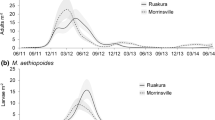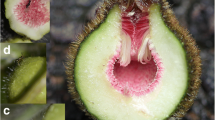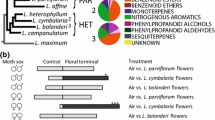Abstract
Exotic pathogen invasions can change host eco-evolutionary interactions and possibly create an evolutionary trap when the pathogen generates mismatches between developmental phenology and reproductive cues. Taylor’s checkerspot butterfly (Euphydryas editha taylori), is an endangered species of western North America with 80 % of the extant populations dependent on an exotic host, Plantago lanceolata. Survey of occupied, recently extinct, and unsuccessful butterfly reintroduction sites spanning 4° of latitude revealed widespread disease on P. lanceolata caused by Pyrenopeziza plantaginis. This fungal pathogen, new to North America, reduces the standing crop of P. lanceolata foliage throughout the winter post-diapause larval feeding period. However, disease is absent when adult butterflies and pre-diapause larvae are active. Diseased plants were frequent in Taylor’s checkerspot populations with a history of persistence, but >90 % of the host plants in these populations had initiated new leaves within the first few weeks of post-diapause larval feeding. Conversely, host plants in recently extinct and unsuccessfully reintroduced populations were severely diseased, >66 % mean foliage necrosis/plant, and <23 % had initiated new leaves. Feeding choice trials with 25 larvae indicated that new leaves were strongly and consistently preferred by post-diapause larvae over all other available leaf types, both diseased and non-diseased. Because the influence of disease on post-diapause larval food resources is developmentally disassociated from oviposition, P. plantaginis invasion appears to have triggered an evolutionary trap for Plantago-dependent populations of Taylor’s checkerspot.



Similar content being viewed by others
References
Agrios GN (2005) Plant pathology, 5th edn. Elsevier Academic Press, Burlington, MA
Berger S, Sinha AK, Roitsch T (2007) Plant physiology meets phytopathology: plant primary metabolism and plant-pathogen interactions. J Exp Bot 58:4019–4026
Brooks CP, Antonovics J, Keitt TH (2008) Spatial and temporal heterogeneity explain disease dynamics in a spatially explicit network model. Am Nat 172:149–159
Burdon JJ (1993) The structure of plant pathogen populations in natural plant communities. Ann Rev Phytopath 31:305–323
Camara MD (1997) A recent host range expansion in Junonia coenia Hübner (Nymphalidae): oviposition preference, survival, growth, and chemical defense. Evolution 51:873–884
Carroll G (1988) Fungal endophytes in stems and leaves: from latent pathogen to mutualistic symbiont. Ecology 69:2–9
Cavers PB, Basset IJ, Crompton CW (1980) The biology of Canadian weeds. 47. Plantago lanceolata L. Can J Plant Sci 60:1269–1282
Core A, Runckel C, Ivers J, Quock C, Siapno T, DeNault S, Brown B, DeRisi J, Smith CD, Hafernik J (2012) A new threat to honey bees, the parasitic phorid fly Apocephalus borealis. PLoS One 7(1):e29639
Crooks JA (2005) Lag times and exotic species: the ecology and management of biological invasions in slow-motion. Ecoscience 12:316–329
Cunningham AA (1996) Disease risks of wildlife translocations. Conserv Biol 10:349–353
Danby WH (1890) The food plant of Melitaea taylori, Edw. Can Ent 22:121–122
Daszak P, Cunningham AA, Hyatt AD (2003) Infectious disease and amphibian population declines. Divers Distr 9:141–150
de Castro F, Bolker B (2005) Mechanisms of disease induced extinctions. Ecol Lett 8:117–126
Dornfeld EJ (1980) Butterflies of oregon. Timber Press, Forest Grove
Ellis MB, Ellis JP (1997) Microfungi on land plants. Richmond Publishing Co., Ltd., Slough
Ellison AM, Bank MS, Clinton BD, Colburn EA, Elliot K, Ford CR, Foster DR, Kloeppel BD, Knoepp JD, Lovett GM, Mohan J, Orwig DA, Rodenhouse NL, Sobczak WV, Stinson KA, Stone JK, Swan CM, Thompson J, Von Holle B, Webster JR (2005) Loss of foundation species: consequences for the structure and dynamics of forested ecosystems. Frontiers Ecol Environ 3:479–486
Gilles T, Fitt BDL, Jeger MJ (2001) Effects of environmental factors on development of Pyrenopeziza brassicae (light leaf spot) apothecia on oilseed rape debris. Phytopath 91:392–398
Graves SD, Shapiro AM (2003) Exotics as host plants of the California butterfly fauna. Biol Conserv 110:413–433
Hartley SE, Gange AC (2009) Impacts of plant symbiotic fungi on insect herbivores: mutualism in a multitrophic context. An Rev Ent 54:323–342
Hedges LM, Brownlie S, O’Neill SL, Johnson KN (2008) Wolbachia and virus protection in insects. Science 322:702
Keeler MS, Chew FS (2008) Escaping an evolutionary trap: preference and performance of a native insect on an exotic invasive host. Oecologia 156:559–568
Kluth S, Kruess A, Tscharntke T (2001) Interactions between the rust fungus Puccinia punctiformis and ectophagous and endophagous insects on creeping thistle. J Appl Ecol 38:548–556
Laine A (2004) A powdery mildew infection on a shared host plant affects the dynamics of the Glanville fritillary butterfly populations. Oikos 107:329–337
Lande R (1993) Risks of population extinction from demographic and environmental stochasticity and random catastrophes. Am Nat 142:911–927
Mack RN, Simberloff D, Lonsdale WM, Evans H, Clout M, Bazzaz FA (2000) Biotic invasions: causes, epidemiology, global consequences, and control. Ecol Appl 10:689–710
Mattson WJ Jr (1980) Herbivory in relation to plant nitrogen content. Ann Rev Ecol Syst 11:119–161
Mitchell CE, Power AG (2003) Release of invasive plants from fungal and viral pathogens. Nature 421:625–627
Moran PJ (1998) Plant-mediated interactions between insects and a fungal plant pathogen and the role of plant chemical responses to infection. Oecol 115:523–530
Myers JH, Bazely D (2003) Ecology and control of introduced plants. Cambridge University Press, Cambridge
Nice CC, Gompert Z, Forister ML, Fordyce JA (2009) An unseen foe in arthropod conservation efforts: the case of Wolbachia infections in the Karner blue butterfly. Biol Conserv 142:3137–3146
Phillips BL, Kelehear C, Pizzatto L, Brown GP, Barton D, Shine R (2010) Parasites and pathogens lag their host during periods of host range advance. Ecology 91:872–881
Prenter J, MacNeil C, Dick JTA, Dunn AM (2004) Roles of parasites in animal invasions. Trends Ecol Evol 19:385–390
Pyle RM (2002) Butterflies of Cascadia: a field guide to all the species of Washington, Oregon, and surrounding territories. Seattle Audubon Society, Washington, USA
Schlaepfer MA, Sherman PW, Blossey B, Runge MC (2005) Introduced species as evolutionary traps. Ecol Lett 8:241–246
Schlaepfer MA, Sax DF, Olden JD (2011) The potential conservation value of non-native species. Conserv Biol 25:428–437
Scriber JM, Slansky F Jr (1981) The nutritional ecology of immature insects. Ann Rev Entomol 26:183–211
Severns PM (2010) Interactions between two endangered butterflies and invasive, exotic grasses in western Oregon, USA. Endangered Species Update 25:35–40
Severns PM, Breed GA (2014) Behavioral consequences of exotic host plant adoption and the differing roles of male harassment on female movement in two checkerspot butterflies. Behav Ecol Sociobiol 68:805–814
Severns PM, Grosboll D (2011) Patterns of reproduction in four Washington State populations of Taylor’s checkerspot (Euphydryas editha taylori) during the spring of 2010. Report submitted to the Center for Natural Lands Management, South Puget Sound. (http://cascadiaprairieoak.org/documents/Patterns-of-Reproduction-Taylors-Checkerspot.pdf)
Severns PM, Warren AD (2008) Saving an imperiled butterfly, Euphydryas editha taylori (Taylor’s checkerspot), by selectively conserving and eliminating exotic plants. Animal Conserv 11:476–483
Severns PM, Sackett K, Mundt CC (2015) Outbreak propagule pressure influences the landscape spread of a wind-dispersed, epidemic-causing, plant pathogen. Landscape Ecol 30:2111–2119
Shapiro AM (2002) The Californian urban butterfly fauna is dependent on alien plants. Divers Distr 8:31–40
Siegal ML, Bergman A (2002) Waddington’s canalization revisited: developmental stability and evolution. Proc Nat Acad Sci 99:10528–10532
Simberloff D (2011) How common are invasion-induced ecosystem impacts. Biol Invasions 13:1255–1268
Singer MC, Thomas CD, Parmesan C (1993) Rapid human-induced evolution of insect-host associations. Nature 366:681–683
Stamp NE (1979) New oviposition plant for Euphydrays phaeton (Nymphalidae). J Lepid Soc 33:203–204
Stone JK, Severns PM, Miller N (2011) Pyrenopeziza plantaginis new to North America. North Am Fungi 6:1–4
Tanaka A, Tapper BA, Popay A, Parker EJ, Scott B (2005) A symbiosis expressed non-ribosomal peptide synthetase from a mutualistic fungal endophyte of perennial ryegrass confers protection to the symbiotum from insect herbivory. Mol Microbiol 57:1036–1050
Tepedino VJ, Bradley VA, Griswold TL (2008) Might flowers of invasive plants increase native bee carrying capacity? Intimations from Capitol Reef National Park, Utah. Natural Areas Journal 28:44–50
Thomas CD, Singer MC, Boughton DA (1996) Catastrophic extinction of population sources in a butterfly metapopulation. Am Nat 148:957–975
TIBCO Spotfire (2010) S + 8.2 for windows. TIBCO Software Inc
Wahlberg N (2001) The phylogenetics and biochemistry of host-plant specialization in melitaeine butterflies (Lepidoptera: Nymphalidae). Evolution 55:522–537
Werren JH (1997) Biology of Wolbachia. Ann Rev Ent 42:587–609
Werren JH, Baldo L, Clark ME (2008) Wolbachia: master manipulators of invertebrate biology. Nature Rev Microbiol 6:741–751
Whiteman NK, Sánchez P, Merkel J, Klompen H, Parker PG (2006) Cryptic host specificity of an avian skin mite (Epidermopitae) vectored by louse flies (Hippoboscidae) associated with two endemic Galápagos bird species. J Parasit 92:1218–1228
Wolff K, Schaal B (2002) Chloroplast DNA variation within and among five Plantago species. J Evol Biol 5:325–344
Acknowledgments
We thank two anonymous private landowners in Oregon and Washington for access to study sites and A. Potter (Washington Department of Fish and Wildlife) for help in the field. An anonymous reviewer and J. Fordyce provided comments that helped improve our manuscript. A portion of this research was funded by the USDA National Forest Service—Olympic National Forest.
Author information
Authors and Affiliations
Corresponding author
Rights and permissions
About this article
Cite this article
Severns, P.M., Stone, J.K. Pathogen invasion triggers an evolutionary trap for an endangered checkerspot butterfly dependent on an exotic host plant. Biol Invasions 18, 3623–3633 (2016). https://doi.org/10.1007/s10530-016-1253-8
Received:
Accepted:
Published:
Issue Date:
DOI: https://doi.org/10.1007/s10530-016-1253-8




